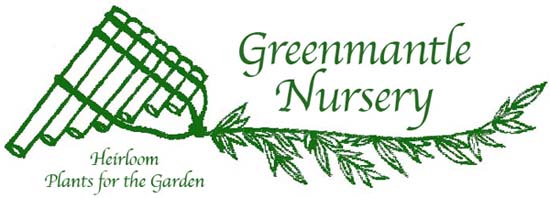
| Our Fruit Collection | ||
| Our Rose Collection | ||
Greenmantle Nursery
3010 Ettersburg Road
Garberville CA 95542
(707) 986-7504
 |
Greenmantle Nursery |
|||||||||
Pears........ Our apologies: We no longer propagate/offer pear trees or benchgrafts. This page for reference only. |
||||
|
In the old abandoned orchards of Southern Humboldt, pears are a distant second to apples in terms of surviving trees. This reflects the pear's less popular status as well as a somewhat greater susceptibility to disease compared to the apple. Nonetheless, there are scores of century-old pear trees still producing in Humboldt County orchards. Our region is very well-disposed to pear varieties, and even the notoriously temperamental Comice makes fine fruit here. In regions where fireblight is endemic, we suggest that customers do some research on resistant varieties. Our catalog can help with descriptions and other information. RootstocksWe graft our trees on domestic pear seedling for standards requiring 20 foot spacing, and OHxF 333 clonal rootstock for semi-dwarf trees (15 foot spacing). Both pear rootstocks tolerate heavier, wetter soils than most other kinds of fruit.
PEAR VARIETIES
While some varieties may be self-fertile under optimum conditions, cross- pollination (two or more varieties) is usually essential. Bartlett and Seckel, however, do not benefit each other. Warren appears closely related to Magness - and may be identical. However, some growers believe it to be more fireblight resistant and regular in bearing..... Winter Bartlett is not related to Bartlett; it is obviously a "sand pear" hybrid in the same class as Kieffer. * * * * * * * * * * * * * * * The burgeoning interest in growing apple varieties specifically for brewing European hard cider has engendered some curiosity about perry - the traditional fermented pear cider of England. Though similar to hard apple cider, perry possesses the distinctive aromatics of pear and often packs a stronger proof of alcohol. There are still over 100 perry pear varieties growing in Herefordshire, Gloucestershire, and Worchestershire. Some varieties go back to the 17th and 18th centuries; moreover, the trees are famously long-lived and many specimens are claimed to be at least 300 years old. These venerable trees constitute a conspicuous feature of the landscape, often planted in avenues and attaining a height of 50 foot. In response to requests from customers, we are now growing a small select list of perry pear varieties. These were obtained through the help of the staff at the National Clonal Germplasm Repository at Corvallis, Oregon. Please Note : The fruit is generally NOT suitable for eatting fresh or even cooking......... Too astringent! Likewise, the fresh pear cider may not prove enjoyable. Perry Pears are grown exclusively for making perry - the legendary fermented cider beverage Barland ( bitter sharp ) Hendre Huffcap ( sweet ) Thorn ( medium sharp ) Winnals Longden ( medium sharp ) Yellow Huffcap ( medium sharp ) * * * * * * * * * * * " Soils seem to have a profound influence on the flavor and texture of pears. In uncongenial soils the fruit are often so sour or astringent, dry or gritty, that the product is poor in quality; whereas the pears of the same variety in a soil to which it is suited are choicely good. A few varieties such as Bartlett. Clapp's Favorite, and Seckel grow well and produce fine fruit in a great diversity of soils, but most sorts do so much better in one soil than in another that it becomes a matter of prime importance in pear growing to discover the particular adaptions of the varieties to be planted. To discover an ideal soil for a variety is about the highest desideratum in pear growing." - U. P. Hedrick, Pears of New York 1921 |
Roses: Master List * * * * * * * * * * * * * |
|||
|
All original text and images © Greenmantle Nursery 2005 -2020 |
||||